Creel fishing: effort study
Report to assess the environmental sustainability of fish stocks and the socioeconomic efficiency of fishing activity.
3. Analysis of Creel Effort
3.1 Nephrops Fishery - West Coast of Scotland
Scottish Nephrops ( Nephrops norvegicus), which developed as a commercial fishery from the 1960s, is now Scotland's second most valuable species with over 15,000 tonnes landed in 2015, worth £40.6 million. Scotland is allocated the majority of Europe's total allowable catch ( TAC) for this species and takes over one third of Nephrops landings worldwide [2] . Nephrops are caught by trawlers operating in both the North Sea and West of Scotland waters, but those caught by creels and sold to the live market are significant on the west coast of Scotland.
Figure 2: Volume and value of Nephrops ( Nephrops norvegicus) landings from the west coast by all UK vessels into Scotland from 2008-2015 broken down by creel (static) and trawled (mobile) gear.
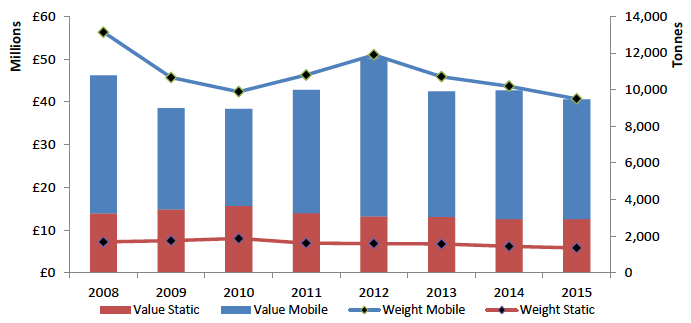
Nephrops landings from both mobile (trawled) and static (creel) vessels operating on the west coast are presented in Figure 2. Landings have remained relatively stable from static gear vessels at around 1,600 tonnes, whilst mobile gear landings have fluctuating between 10,000 and 13,000 tonnes between 2008 to 2015. The value of the fishery has also remained relatively stable over the same period for static gear vessels at around £14 million whilst mobile gear values have ranging from £23 million to £32 million with a spike in 2012 of £37 million (Fig. 2).
Effort analysis from the two survey regions found 54 of the 72 surveyed static vessels used creels to target Nephrops. These vessels accounted for 77% of landings into these regions in 2015. All of these vessels used the industry standard D-shaped prawn creel (Fig. 3) to target Nephrops. Around 30% of vessels surveyed had some form of adaptation to their fishing gear, which was mainly escape panels which, in most cases, were inherited from previous owners involved in a scheme, or reduced size of the hard-eye (from 85 to 65 mm) in the entrance panels.
Figure 3: Standard D-Shaped prawn creel (left) and hard-eye (right). ©Gael Force - www.gaelforcegroup.co.uk
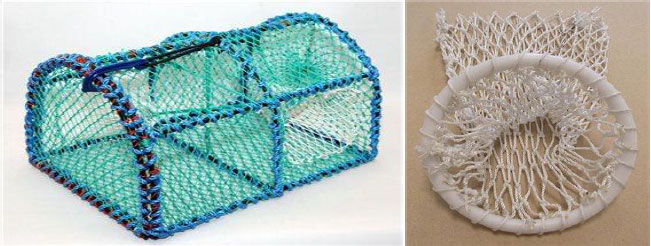
The total number of creels that vessels have access to i.e. owned or could rent was used to represent maximum fishing capacity at any given time. This ranged from 50 to 3,000 creels per vessel and the number deployed i.e. the amount actively fishing in the water, ranged from 50 to 2,500 creels per vessel. Creel numbers at the lower end (50 - ~450) were on vessels generally targeting other species as their main catch but which operated a few prawn creels in suitable grounds, whereas vessels working 1,000s of creels were concentrating exclusively in the Nephrops fishery. The average (mean) number of creels that surveyed boats had access to was 1,009 creels whilst the deployed capacity i.e. the amount of creels in the water, was a mean of 925 creels (Table 2).
Table 2: Mean number of Nephrops creels per vessel by length and number of crew
| Mean number of creels (access to) | Mean number of creels (deployed) | |
|---|---|---|
| All vessels | 1,009 | 926 |
| Length of Vessel | ||
| <5 m in length | 778 | 705 |
| 5-9.9 m in length | 933 | 906 |
| 10-12 m in length | 1,339 | 1,186 |
| >12.1 m in length | 1,583 | 1,469 |
| Number of Crew | ||
| 1 crew member | 644 | 617 |
| 2 crew members | 1,128 | 1,167 |
| 3+ crew members | 2,093 | 1,693 |
Fishing capacity is often associated with the size of vessel because of the size of the deck space for handling gear or the number of crew employed because of the man power available to haul and clear creels. When broken down by length of vessel and number of crew, the mean number of creels for under (<)5 metre vessels was 778 (705 deployed), slightly higher than the mean for vessels which supported 1 crew member at 644 (617 deployed). Vessels between 5 and 9.9 metres in length have access to a mean of 933 (906 deployed) creels. Vessels with length 10 to 12 metres and over (>)12 metres had mean creels number of 1,339 (1,186 deployed) and 1,583 (1,469 deployed), respectively. For vessels with 2 crew, creel numbers were much lower at 1,128 (1,167 deployed) and substantially higher with 3+ crews with access to 2,093 creels, but deploying a mean of 1,693 creels per vessel (Table 2).
A plot of all surveyed vessels' maximum number of creels deployed (Fig. 4) shows that around 10% of surveyed vessels deployed over 2,000 creels, around 25% deployed between 1,000 to 1,999 creels. The remaining 65% of vessels deployed under 1,000 creels. What this graph (Fig. 4) demonstrates is the current volume of creel capacity deployed, which is the whole area below the solid blue line. When thinking about management, care needs to be taken when defining who the management will impacts and what other incentives are awarded by a management intervention. For example by applying a (hypothetical) 1,500 creel limit, you will be impacting on the capacity in the red area, but legalising and potentially incentivising an increase in capacity represented in the grey area. This may be the best option if there is little likelihood that low capacity vessels will increase their creel numbers, but a full understanding of the capacity of the fleet and likely incentives of a management intervention is required to assess this risk.
Figure 4: Plot of the reported number of creels deployed by each vessel surveyed in the west coast Nephrops fishery. Red shaded area - demonstration of impacts to creel capacity if 1,500 creel limit imposed, grey shaded area is the potential additional creel capacity legalised by such a regulation.
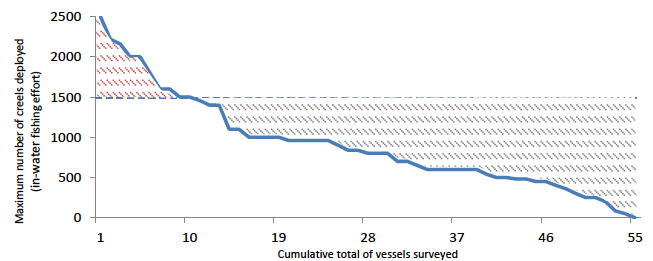
Total number of creels deployed per month by all vessels surveyed showed small increases throughout the year from around 49,000 creels in December up to 53,600 creels in May (Fig. 5). There was a small drop in creel numbers (~1,730) during June and July due to some vessels fishing during spring months only. In the case of august it appears that most vessels increase their fishing effort during that month.
Figure 5: Total number of Nephrops creels from surveyed vessels deployed per month
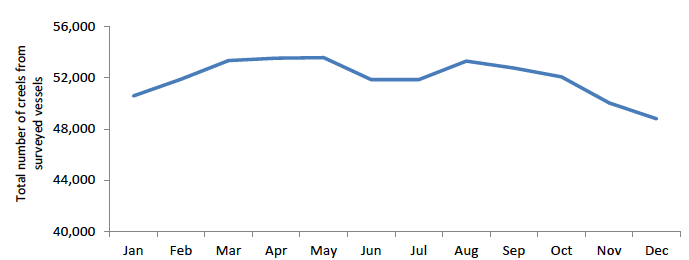
From the 31 vessels who gave details of their daily hauling patterns, the mean number of creels hauled per day, per person, was 401, with 700 creels quoted as the maximum hauled by one crew member in a day. Most vessels stated that they hauled gear on alternative days, so creels generally had a 48 hour soak time, and they fished five days a week, resulting in some creels soaking for 72 hours at weekends. Fishing patterns varied seasonally and weather was cited as the most significant factor for changing fishing patterns, although some respondents also mentioned markets, low quality or poor fishing as factors which led them to deviate from normal fishing patterns. A number of skippers discussed leaving gear for weeks in bad weather as Nephrops gear generally fishes at depth on soft substrate, so is unlikely to get damaged by strong currents.
Applying the haul rates and monthly creel numbers per vessel, Figure 6 maps an estimate of average number of crab and lobster creels hauled per day by all vessels surveyed. This is produced by calculating total reported hauls per month multiplied by the total number of pots deployed per month in each fishing ground per vessel. This is then totalled for all 12 months and divided by 365 days to get an average haul rate per day per vessel. This total is divided across the reported fishing ground. A grid is then placed across the whole area and the total number of hauls per day from all fishing vessels is calculated for each cell in the grid. Each cell cover a 4 km 2 area of sea so presents the average number of hauls of Nephrops creels per 4 km 2.
For the Nephrops fishery the lighter areas displayed in Figure 6 show average hauls rates ranging from 0.1 to 35 hauls per day per 4 km 2. The medium coloured areas show ranges from 36 to 107 hauls per day per 4 km 2 and for the dark areas show ranges from 108 to 419 haul per day per 4 km 2.
Figure 6: Average number of Nephrops pots hauled per day per cell (4 km 2) from the 55 surveyed vessels. This does not represent effort from all vessels in the fleet.
Average number of nephrop hauls per cell per day
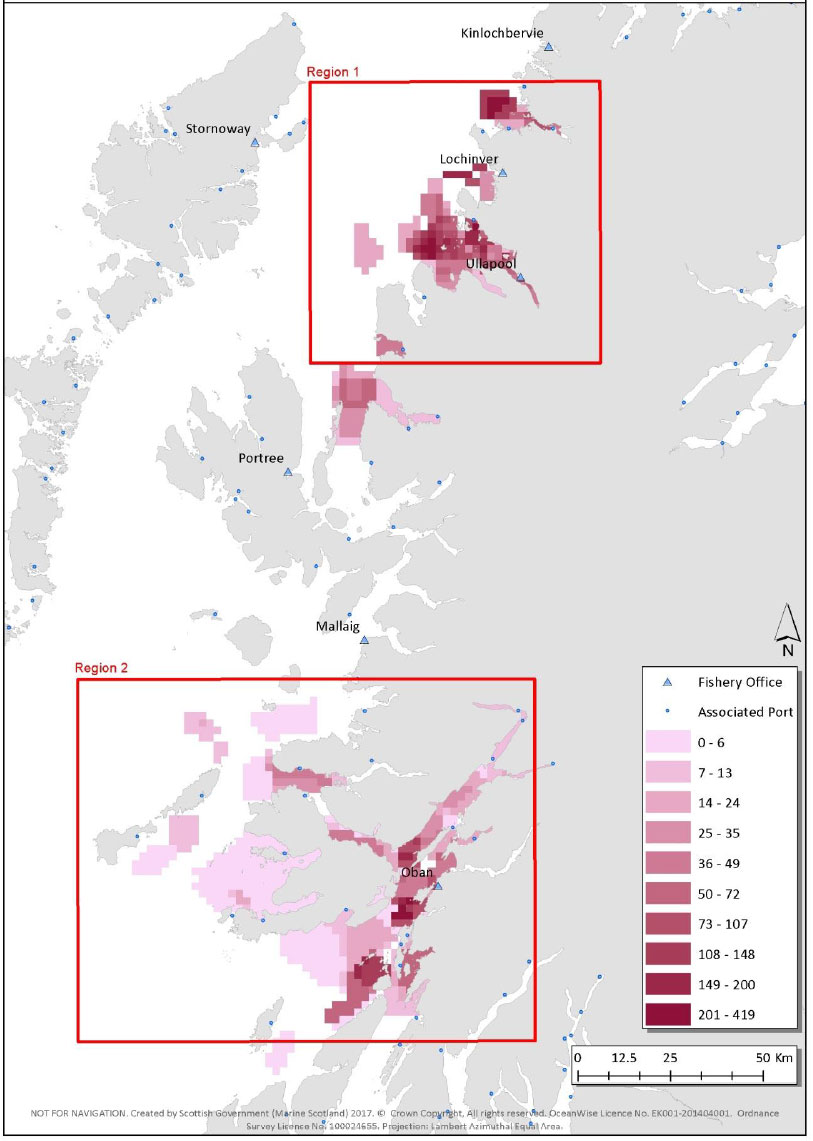
Figure 7: Average number of Nephrops creels in the water per cell during the peak season (August) from the 55 surveyed vessels. This does not represent effort from all vessels in the fleet.
Average number of nephrop pots per cell during peak period (August)
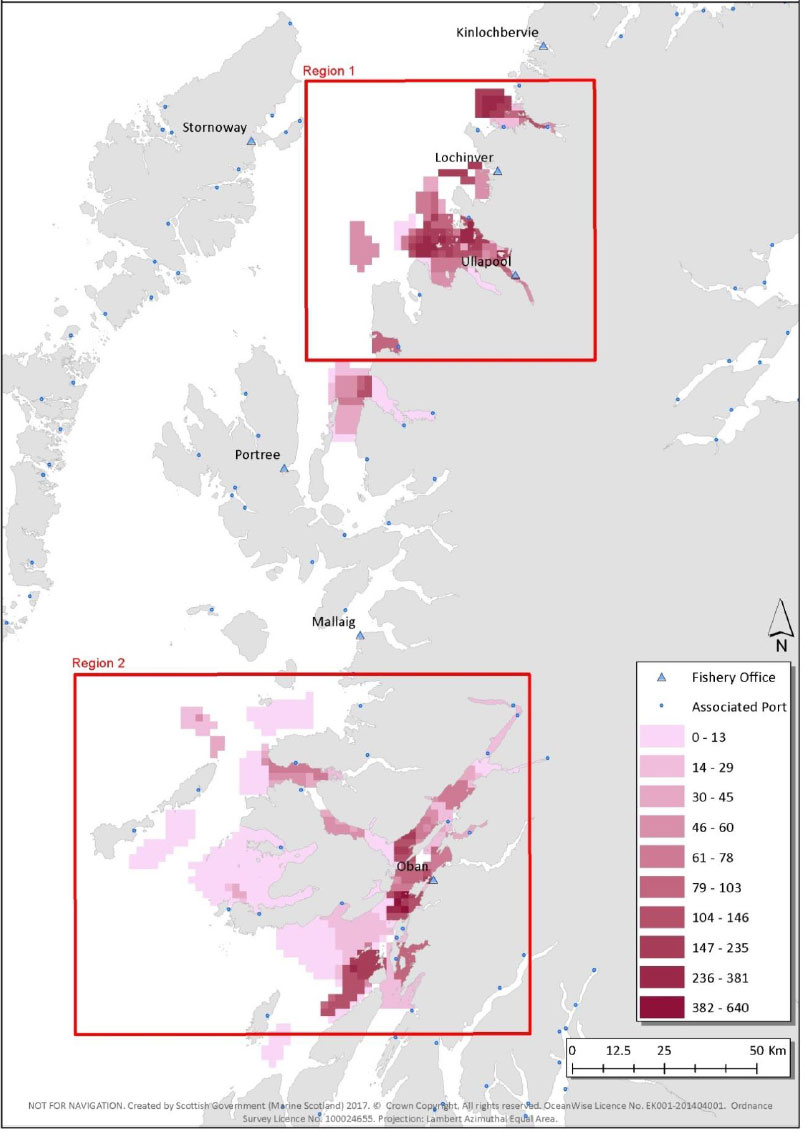
Figure 7 presents the average number of creels deployed per 4 km 2 during the peak month of August. This represents the amount of gear surveyed fishers said they had in the water during this month. Gear deployment rates in the lighter areas ranged from 0.1 to 45 creels per 4 km 2. The mid-intensity coloured areas show ranges from 46 to 103 creels per 4 km 2 and the dark areas range from 104 to 640 creels per 4 km 2. These top rates can be considered as maximum fishing capacity during this mouth estimated from surveyed vessels across these fishing grounds.
3.2 Crab and Lobster Fishery - West Coast of Scotland
Crab and lobster are important fisheries in Scotland, brown crab ( Cancer pagurus) because of the volume landed, European lobster ( Homarus gammarus) because of its high value and velvet crab ( Necora puber) as a relatively recent seasonal fishery. Landings of brown crab into Scotland totalled 11,000 tonnes in 2015 with a value of £14 million (Fig. 8). The majority of brown crab comes from West of Scotland waters (54%) the remaining from the North Sea (46%). Catch rates have remained relatively stable since 2011 after an increase in tonnage landed. The value of these landings has increased from around £11 million in 2008 to £14 million in 2015 (Fig. 8). This fishery is long established and traditionally most brown crab was caught using creels in inshore waters but from the mid 1980s technological advances allowed the fishery to expand to offshore fishing grounds. Inshore grounds now accounts for around two thirds of brown crab landings and the remaining is caught offshore [3] .
Figure 8: Volume and value of brown crab ( Cancer pagurus) landings from all UK vessels into Scotland from 2008-2015
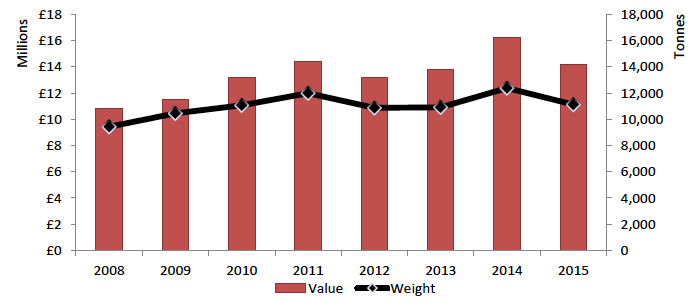
The European lobster is an important fishery to Scotland worth around £11 million in 2015 from just over 1,000 tonnes of landed lobster (Fig. 9). The majority of lobster was taken from the North Sea (71%) and the remaining from west of Scotland waters (29%) in 2015. Lobster landings have remained relatively stable since 2008, with the exception of a small dip in 2013, fluctuating between 1,000 and 1,200 tonnes per year. Prices have also fluctuated between £10 million and £13 million over the same period (Fig. 9).
Figure 9: Volume and value of European Lobster ( Homarus gammarus) landings from all UK vessels into Scotland from 2008-2015
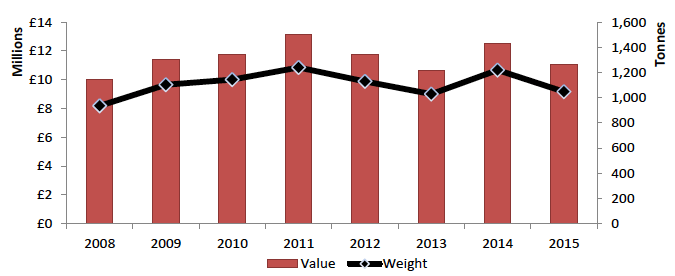
Velvet crab, traditionally considered a 'pest' species, is now a seasonal fishery which became financially viable in Scotland because of stock collapse in the Spanish fishery in the early 1980s. Scotland now supports the largest velvet crab fishery in Europe [4] . In 2015, 1,500 tonnes of velvet crab were landed into Scotland with a value of £3.7 million. Landed weight in this fishery has been on the decline year on year from 2,700 tonnes in 2008 (Fig. 10). This is also reflected in the value of the fishery although prices per tonne have held or increased over this period.
Figure 10: Volume and value of Velvet crab ( Necora puber) landings from all UK vessels into Scotland from 2008-2015
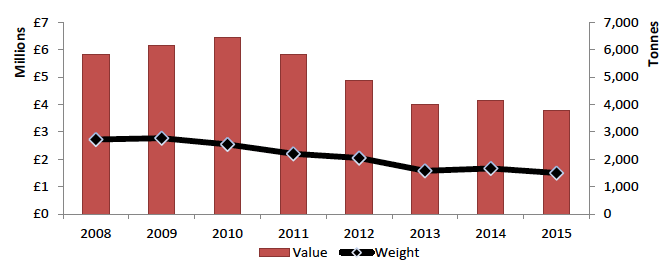
Effort analysis from the two surveyed regions on the west coast of Scotland recorded 39 boats using creels to target brown crab, velvet crab and lobster. The majority of vessels used the industry standard D-shaped lobster creels (54%) or a mixture of D-shaped lobster/crab creels with parlour creels or crab pots (28%) (Fig. 11). The remaining 18% used parlour creels exclusively. Very few vessels had any forms of adaptation to their gear (7%), which consisted of changes to entrances. These compositions of lobster/crab creels and parlour creels are jointly referred to as 'creels' in the remaining analysis.
Figure 11: Standard D-shaped lobster/crab creel (top left). Parlour pots with hard eye entrances (top, right) and 24 inch crab and lobster creel with soft eye entrances (bottom left) ©Cornwall Creels - www.cornwallcreels.co.uk .
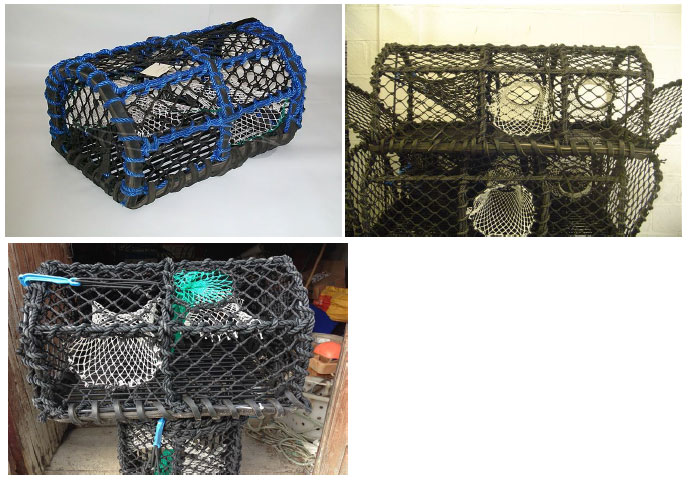
The number of creels that vessels had access to i.e. owned or could rent, which were used to represent maximum fishing capacity to target crab and lobster ranged from 30 to 1,200 creels and the maximum number deployed i.e. the amount actively fishing in the water, ranged from 40 to 900 creels. A plot of each surveyed vessel's maximum creel numbers deployed shows small number (13%) of vessels deploy 600+ creels and a large number of vessels (49%) deploying less than 200 creels (Fig. 12).
Figure 12: Plot of the reported number of creels deployed by each vessel surveyed in the west coast crab and lobster fishery
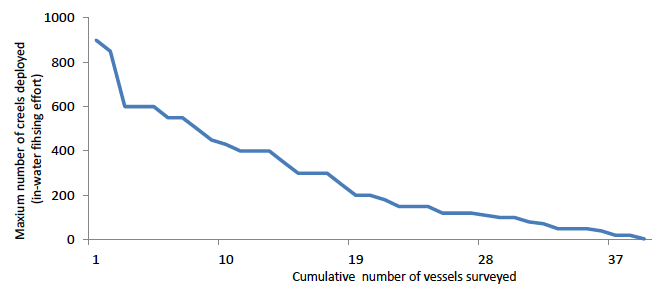
As with the Nephrops fishery, individual vessels which worked across a number of fisheries generally deployed lower numbers of crab and lobster creels (40 to 600) than those which worked exclusively in the crab or lobster fishery, which ranges between 60 to 1,200 creels. The average (mean) number of creels a boat had access to was 359 whilst the numbers deployed averaged 294 creels (Table 3).
Table 3: Average (mean) number of crab and lobster creels by vessel length and number of crew
| Mean number of creels (access) | Mean number of creels (deployed) | |
|---|---|---|
| All vessels | 359 | 294 |
| Length of vessel | ||
| <10 min length | 379 | 302 |
| >10 min length | 260 | 254 |
| Number of crew | ||
| 1 crew member | 593 | 476 |
| 2 crew members | 247 | 219 |
When broken down by length of vessel and number of crew, the average (mean) number of creels that an under(<) 10 metre vessel had access to was 379 (294 deployed) and for vessels over(>) 10 metres in length they had access to an average of 379 (302 deployed) creels. For vessels worked by 1 crew member the average number accessed was 593 (476 deployed) and for worked by 2+ crews, average creels accessed was much lower at 247 (219 deployed) (Table 3). This was mainly due to bigger vessels working in other fisheries, such as Nephrops as well as working crab and lobster creels.
Information on hauling patterns showed that the majority of vessels reported hauling their crab and lobster creels 3 to 5 days a week during summer months and once or twice a week during winter months. Generally those targeting crabs were hauled more regularly whereas those targeting lobster were left longer before being cleared. Fishers targeting velvet crab said they usually hauled their gear every day during the season, weather permitting. Most vessels stated that they hauled all their crab and lobster gear in one day and then worked gear targeting other species on the alternate day, so generally crab and lobster creels have a 48 hour soak time during the summer months. During the winter months, the time creels were left in the water increased to up to a week before being cleared with weather, seasonality of catches and markets being factors impacting on winter fishing patterns.
Applying these fishing patterns, figure 13 maps an estimate of number of crab and lobster creels hauled per day in the two west coast survey areas. As before, this is produced by calculating the total reported hauls per month by the total number of pots deployed per month for each boat in each fishing ground. This is then totalled for all 12 months and divided by 365 days to get an average haul rate per day. This total is then divided across each fishing ground, as identified by fishers. A grid is then placed across the whole area and total hauls per day from all fishing vessels are totalled for each cell in the grid. Each cell covers a 4 km 2 area of sea, therefore each cell present the range of average number of hauls of crab and lobster creels, per day, per 4 km 2.
In the light areas average effort ranged from 0.1 to 3 hauls per day per 4 km 2. For medium coloured celled effort ranged from 3.1 to 10 hauls per day per 4 km 2 and for the darker areas effort ranged from 10.1 to 47.6 hauls per day per 4 km 2.
Figure 13 presents haul rates and the spatial distribution from the 39 surveyed vessels in the two surveyed regions only. These effort estimate however do not indicate the full spatial distribution of total effort as not all active vessels were interviewed. These maps do however start to highlight important grounds for crab and lobster fishing around the Isle of Mull and Wester Ross bay.
Figure 13: Estimated number of creels hauled per day per cell (4 km 2) from surveyed vessels
Average number of crab/lobster hauls per day per cell
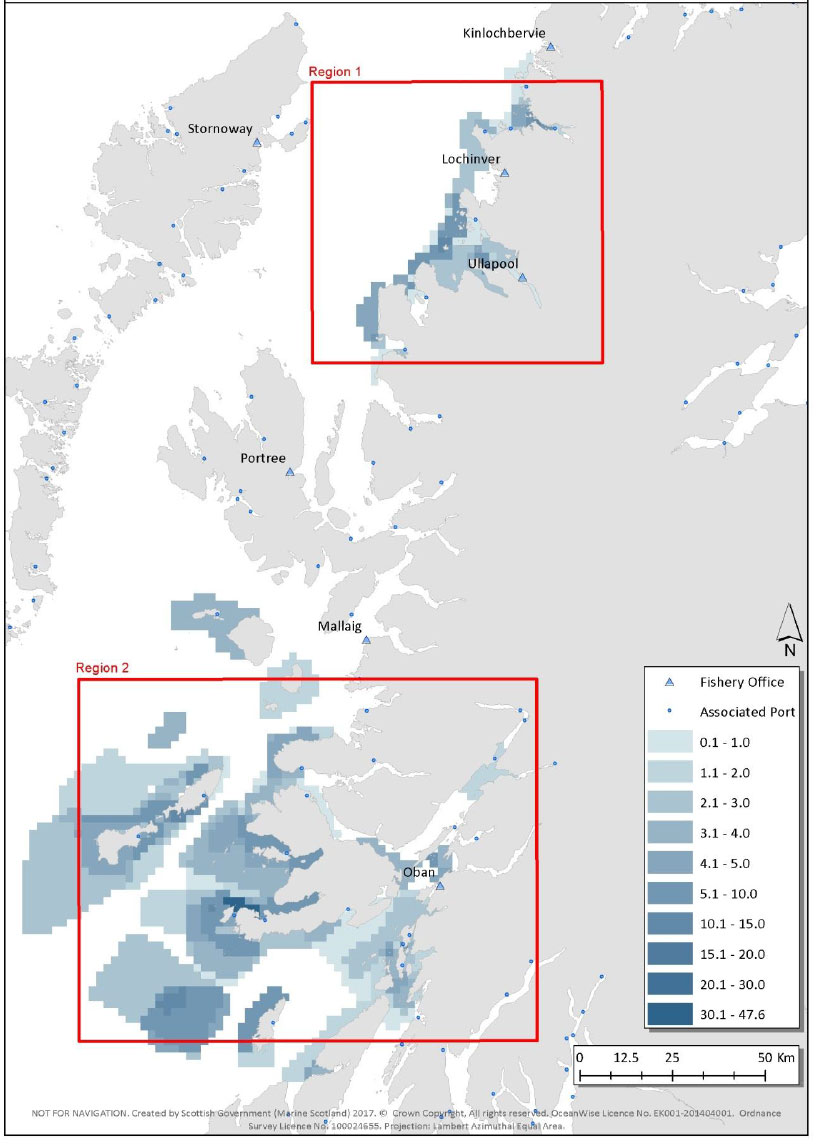
3.3 Crab and Lobster Fishery - East Coast of Scotland
As on the west coast of Scotland, east coast creel fishers target all three species, brown crab ( Cancer pagurus), European lobster ( Homarus gammarus) and velvet crab ( Necora puber). Many also target mackerel ( Scomber scombrus) for commercial sale and as bait to use in creels.
Effort analysis from the two surveyed regions on the east coast of Scotland surveyed 130 boats using creels to target crab and lobster. The majority of vessels fished exclusively with parlour creels (67%), followed by those who used solely lobster/crab creels (19%). The remainder use a mixture of lobster/crab creels with parlour creels (14%). Around 22% of vessels had adaptation to their gear, which consisted of escape panels on some creels in their fleets. A number of interviewees said they had tied the escape panels due to high escape rates of commercial size velvet crab. As before, lobster/crab creels and parlour creels are jointly referred to as 'creels' in the remaining analysis.
The number of creels that vessels had access to target crab and lobster on the east coast ranged from 10 to 2,300 and the same range was reported for those deployed. Figure 14 presents the numbers of creels deployed by each vessel which varied substantially. A small proportion of vessels deployed more than 1,000 creels (8.4%), a high proportion of vessels (60%) deployed under 500 creels per vessel and the remaining 31.6% deployed between 500 and 999 creels per vessel.
Figure 14: Plot of the reported number of creels deployed by vessels surveyed in the east coast crab and lobster fishery
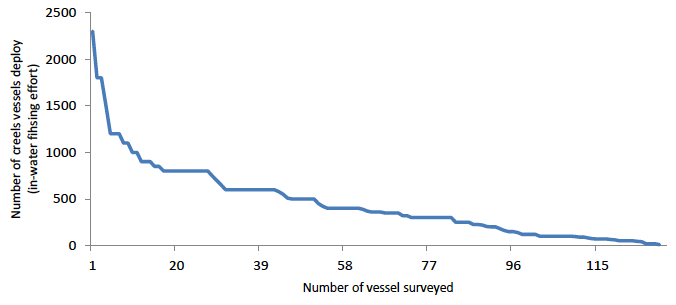
The total number of creels deployed per month by all vessels surveyed increased by almost a third from 41,500 in February up to 60,000 in the peak month of August (Fig. 15). Peak season appears to run for five months from May through to September where on average 59,700 creels (all vessels combined) are deployed per month. This is in comparison to the low season, the seven months from October to April where an average of 47,500 are deployed by all surveyed vessels per month. This is an additional 12,000 creels in high season compared to low season.
Figure 15: Total number of creels deployed by surveyed crab/lobster east coast vessels by month

The number of creels a vessel had access averaged 542 creels whilst the deployed 'effort' was an average of 455 creels (Table 4).
Table 4: Average (mean) number of crab/lobster creels per vessel by length and crews east coast
| Mean number of creels (access) | Mean number of creels (deployed) | |
|---|---|---|
| All vessels | 542 | 455 |
| Length of vessel | ||
| <5 m in length | 267 | 261 |
| 5-9.9 m in length | 506 | 415 |
| >10 m in length | 1,294 | 1,161 |
| Number of crew | ||
| 1 crew member | 437 | 360 |
| 2 crew members | 716 | 609 |
| 3+ crew members | 1,137 | 1,088 |
As before, Table 4 shows the average number of creels accessed and deployed by length of vessel and number of crew for the east of Scotland crab and lobster fishery. Hauling patterns from the vessels who supplied this data ( n = 120) show much variation in days fishing and hauling rates. For fishing days, around 35% of the vessels surveyed fished during the spring and summer months only and was split between those who fished 6 to 7 days a week and those who fished between 3 to 4 days a week. The remaining 65% fished all year round. Fishers who worked all year, gave either an average annual figure of fishing days per week (24%) or two figures: one from summer and one winter (76%). Those who gave just one figure: the majority said they fished on average 3 to 4 days a week whilst a very small proposition said they fished 5 to 6 days a week. Those who gave summer and winter figures: the majority (90%) fished between 5 to 7 days a week in the summer and between 3 to 4 days in the winter. The remaining 10% fished less days during both summer (>4 days a week) and winter (>3 days a week).
Hauling rates per day varied with the average (mode - the most commonly reported figure) of 300 creels per vessel which ranged from 20 to a maximum of 500 creels hauled by on vessel in one day. When broken down according to number of crew, the most commonly reported haul rate per day was 200 creels for a 1 crewed vessel, 300 creels for a 2 crewed vessel and 500 creels for a 3+ crewed vessel (Table 5).
Table 5: Average (mode) haul rates per day for all surveyed vessels broken down by crew number
| All vessels | 1 crew | 2 crew | 3+ crew | |
|---|---|---|---|---|
| Range | 20 - 500 | 20 - 500 | 70 - 580 | 360 - 500 |
| Most common (mode) | 300 | 200 | 300 | 500 |
Mapped estimates of crab and lobster creels hauled per day per 4 km 2 for the east coast areas are presented in figure 16. Haul rates ranged from 1 to 234 hauls per day per 4 km 2. For the light areas average hauls rates range from 0.1 to 11 hauls per day per 4 km 2. For medium coloured cells this ranges from 12 to 40 hauls per day per 4 km 2 and for the dark areas this ranges from 41 to 234 haul per day per 4 km 2. Haul rates per day in inshore waters are substantially higher, compared with offshore areas on the east coast.
Figure 16: Estimated number of creels hauled per day per cell (4 km 2) from surveyed vessels
Average number of crab/lobster hauls per day per cell
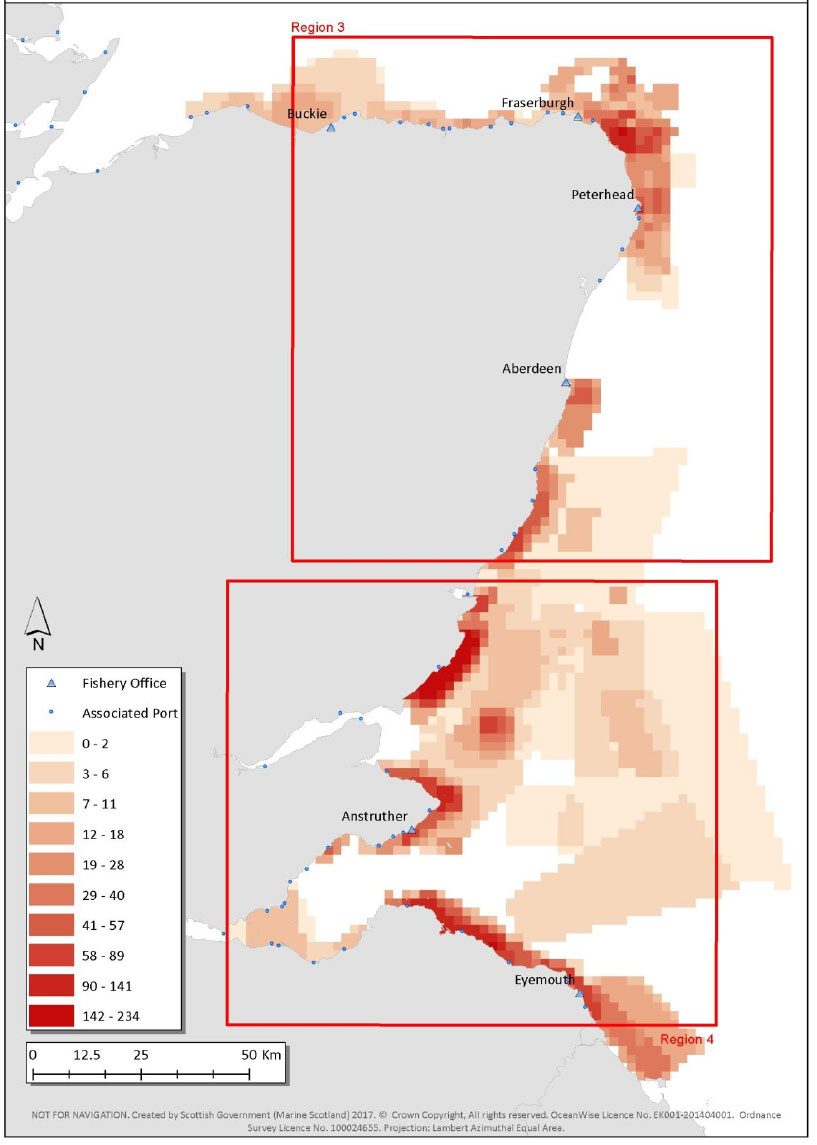
3.4 Additional Creel Fishing Data
Creel fishing requires bait to attract target animals and encourage them to enter the creels. Figure 17 shows the composition of species fishers said they used to bait creels in each of the fisheries. For the West of Scotland Nephrops fishery (left chart) the species most commonly used as bait was herring, followed by mackerel and saithe and the majority of bait is salted to deter crab. Species in the 'other' category included, scad, swimming crab, gurnard and pout.
Figure 17: Breakdown of species used as bait in the West of Scotland Nephrops fishery (left), the West of Scotland crab and lobster fishery (centre) and the East of Scotland crab and lobster fishery (right).
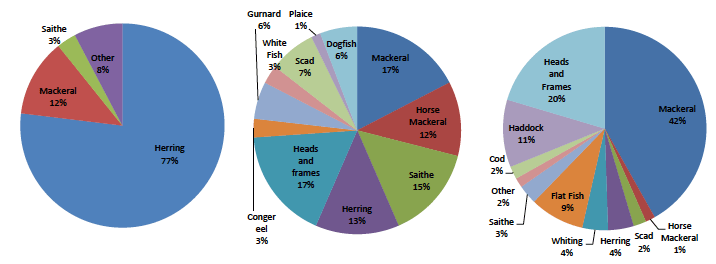
The middle chart shows the species used to bait crab and lobster gear on the West of Scotland. The species composition is much more mixed than the Nephrops fishery, with both oily (mackerel, horse mackerel and herring) and white fish (saithe, gurnard and scad) making up the majority of species. The heads and frames of salmon and whitefish were also used to bait creels in this fishery. The right charts shows the composition of species used to bait crab and lobster gear on the east coast. Mackerel is the dominant species which is used both fresh and salted. Heads and frames mainly of haddock were the second most used bait species, followed by fresh haddock. Flat fish were also regularly used by some fishers and a mixed of other whitefish species at lower volumes.
To gather data on the interactions of Nephrops creels with other marine species, fishers were asked what other species they commonly encountered when hauling their creels. Squat lobster was the species most cited by fishers , followed by brown crab, octopus and cod (Fig. 18). Most fishers reported an increase in cod/codling (juvenile cod) over recent years compared to the past. Others discussed the increase in octopus which predates on Nephrops. A total of 27 species were cited as interacting with Nephrops gears.
Figure 18: Most commonly encountered species in Nephrops gear cited by interviewees
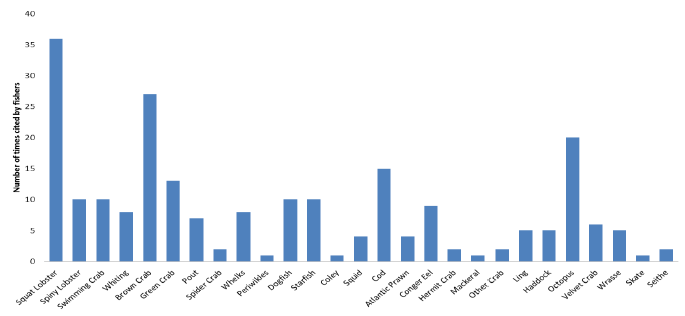
Figure 19: Most commonly encountered species in West of Scotland crab and lobster gear cited by interviewees
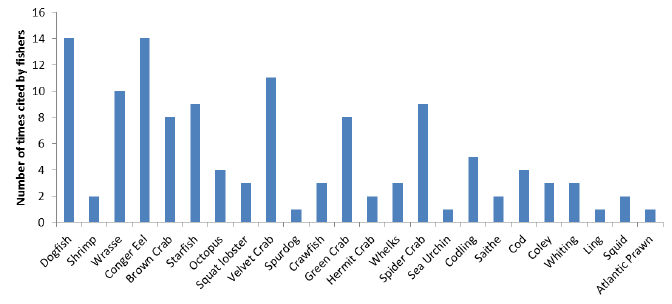
Figure 20: Most commonly encountered species in east coast crab and lobster gear cited by interviewees
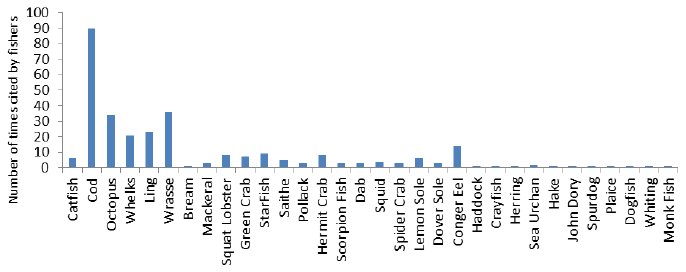
In the West of Scotland crab and lobster creels, 24 species where cited by fishers as encountered (Fig. 19). The two most common species were dogfish and conger eel, followed by wrasse, velvet crab, spider crab and green crab. Velvet and brown crab were included on these by-catch lists as they were undersized and therefore discarded.
On the east coast, 32 species where cited by fishers as encountered in crab and lobster creels (Fig. 20). The most common species was cod listed 90 times, followed by wrasse, octopus, ling and whelk (20-30 times each). A much wider range of other species were listed as interacting with east coast creels compared to the west coast. This could be due to higher survey sampling on the east coast, data collection methods (all species encountered rather than most common) or higher retention rates in parlour creels, which dominate on the east coast as opposed to D-shape prawn creels which dominate on the west coast.
Contact
Email: Estelle Jones, estelle.jones@gov.scot
Phone: 0300 244 4000 – Central Enquiry Unit
The Scottish Government
St Andrew's House
Regent Road
Edinburgh
EH1 3DG
There is a problem
Thanks for your feedback